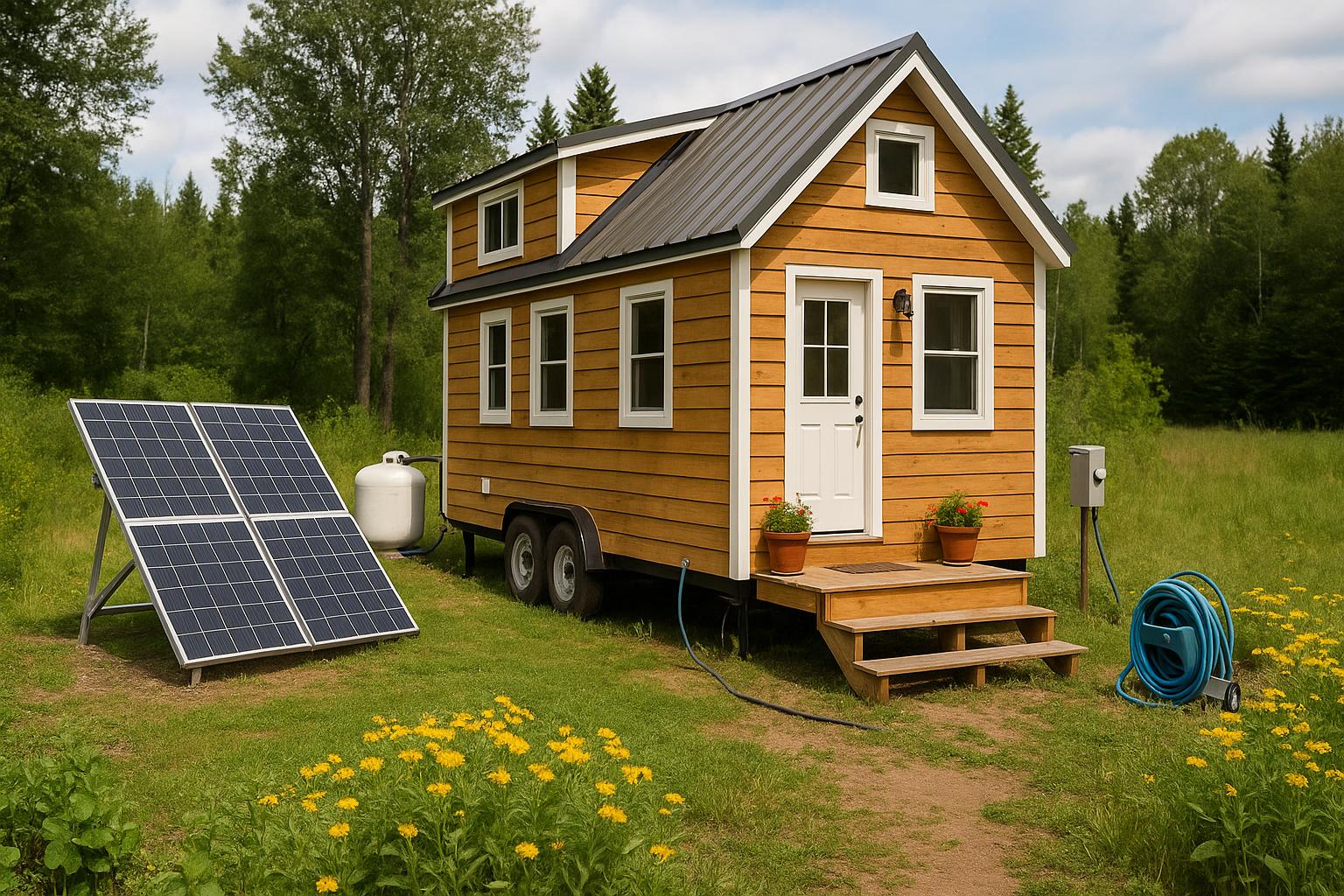
Tiny Home Utilities: The Complete Guide to Utilities for Tiny Home Living in Canada
Estimated reading time: 8 minutes
Key Takeaways
- Essential Components: Tiny home utilities cover the critical systems such as electricity, water supply, and waste management.
- Local Adaptation: Unique Canadian infrastructure requires a mix of grid and off-grid solutions.
- Smart Planning: Balancing cost, convenience, and sustainability is key to successful tiny home living.
Table of contents
- Introduction: What Are Tiny Home Utilities?
- Tiny Home Living Essentials: Key Utilities You Need
- Canadian Infrastructure and Tiny Home Utilities
- Off-Grid Solutions for Tiny Home Utilities in Canada
- Water Systems for Tiny Homes: Practical Approaches
- Utilities Trade-offs and Realities for Tiny Home Dwellers
- Conclusion: Planning Tiny Home Utilities for Success
- Frequently Asked Questions
Introduction: What Are Tiny Home Utilities?
Tiny home utilities are the essential building blocks that make tiny home living viable and comfortable—especially across the diverse Canadian landscape. The term tiny home utilities refers to the critical systems needed for day-to-day life such as electricity, water supply, and waste management. Without effective utilities, tiny homes cannot deliver on their promises of comfort, safety, and sustainability.
In recent years, there has been a sharp rise in interest among Canadians for affordable, flexible housing solutions. Many opt for off-grid systems to achieve sustainability while reducing reliance on traditional city services. For market insights, refer to Canada Tiny Homes Market Overview – Data Bridge Market Research and Tiny Homes Market Report – UnivDatos. Additional guidance can be found at this tiny home living guide.
Tiny Home Living Essentials: Key Utilities You Need
To live comfortably in a tiny home, certain utilities are non-negotiable:
- Electricity – Powers heating, lighting, devices, and essential systems.
- Water Supply – Provides fresh, potable water for drinking, cooking, and cleaning.
- Waste Management – Manages toilets, shower drainage, and greywater control.
Traditional hookups often limit mobility and sustainability. Canadians are increasingly turning to off-grid systems to minimize environmental impact and gain independence. For further reading, see Tiny Homes Market – Mordor Intelligence and Tiny Homes Market Report – UnivDatos. More insights are also provided by this guide.
Canadian Infrastructure and Tiny Home Utilities: What You Need to Know
Canadian infrastructure both enables and limits utility setups. The difference between urban and rural settings influences legal, technical, and practical choices.
Urban vs. Rural: Regional Differences in Utility Access and Bylaws
- Urban Centres: Cities like Toronto, Vancouver, and Ottawa have robust utility networks. Progressive zoning and bylaw changes, such as Ontario’s ADU program, make tiny homes more feasible. For more about urban regulations, visit this guide.
- Rural and Remote Regions: Limited infrastructure pushes homeowners to adopt off-grid solutions, such as solar panels and private wells. For insights into rural opportunities, see this resource.
Zoning and legal considerations vary widely. Mobile tiny homes, often registered as RVs, enjoy more flexibility than stationary ones, which must comply with strict local codes. More legal details can be found at this page and this connection guide.
For additional context, learn more from Mordor Intelligence and check out YouTube: Zoning for Tiny Homes in Canada.
Off-Grid Solutions for Tiny Home Utilities in Canada
Off-grid solutions offer the freedom to live almost anywhere, though they require more planning and technical know-how.
Popular Off-Grid Utility Options
- Solar Panels and Battery Storage: Modern panels paired with batteries power small appliances even in harsh winters. For technical guidance, check out this resource.
- Wind Turbines: Ideal for areas with strong, consistent wind, they can complement solar energy.
- Composting Toilets: These reduce reliance on septic systems and require regular maintenance. See this guide for details.
Electricity and Heating Solutions
Canadian winters demand innovative solutions. Many tiny homes combine solar or wind systems with propane generators, wood stoves, or mini-split heat pumps. For more on winter-proofing, visit this resource.
Water Systems Off-Grid
- Rainwater Collection: Collects roof runoff but must be filtered and insulated. Learn more at this guide.
- Greywater Recycling: Recycles water from sinks and showers for non-potable uses. Detailed information is available at this page.
Off-grid systems may have higher initial costs and require regular maintenance, but they offer increased independence and sustainability.
For further insights, refer again to Mordor Intelligence and UnivDatos.
Water Systems for Tiny Homes: Practical Approaches
Reliable water is the cornerstone of tiny home utilities. Whether connecting to municipal lines or adopting off-grid solutions, careful planning is required.
Types of Water Systems
- Rainwater Harvesting: Captures roof runoff in tanks that require multi-stage filtration. More details at this guide.
- Greywater Recycling: Treats wastewater from showers and sinks for reuse. See this resource for design details.
- Traditional Municipal Hookups: Offer reliable water quality but are limited to serviced areas.
Meeting Canadian Climate Challenges
Water systems must be designed to withstand extreme cold. This includes strategies like burying pipes below the frost line, using insulated tanks indoors, and adding heat cables. Safety and regulatory standards are paramount.
For more on maintaining safe water systems, visit this comprehensive guide.
Utilities Trade-offs and Realities for Tiny Home Dwellers
Every utility setup involves trade-offs. Here are some real-life challenges and compromises:
Convenience vs. Cost
Off-grid systems, while offering independence, usually come with higher upfront costs and require routine maintenance. However, the long-term savings and environmental benefits often outweigh these initial investments.
Sustainability vs. Self-Sufficiency
Complete independence means managing your own water, power, and waste systems. This lifestyle demands regular monitoring and seasonal maintenance, but it also provides more control over your environmental footprint.
Real-Life Utility Setups
- Multi-Source Energy: Many Canadian tiny homes use a blend of solar power, propane generators, and wood stoves for reliable energy.
- Water & Waste Management: Dual systems, combining municipal hookups with off-grid backups, ensure year-round reliability. For further information on waste management, see this composting toilets guide.
- Urban Setups: Homeowners benefit from municipal ADU programs while still optimizing efficiency through downsizing.
Active maintenance, like regular filter changes and winterizing procedures, is essential to keep systems running smoothly. For more on maintenance, visit this maintenance checklist.
More examples and detailed trade-offs can be found via Mordor Intelligence and YouTube: Zoning for Tiny Homes in Canada.
Conclusion: Planning Tiny Home Utilities for Success in Canada
Effective planning and smart utility choices are essential for thriving in tiny home living. Ensuring reliable, sustainable, and code-compliant utilities keeps you safe and comfortable throughout the year.
To set yourself up for success:
- Research Thoroughly: Study local zoning codes and infrastructure, and assess off-grid solutions that fit your climate and budget. See this comprehensive guide for more details.
- Use Community Resources: Leverage municipal guidelines and connect with experienced homeowners to gather practical insights.
- Balance Trade-Offs: Off-grid or hybrid setups require maintenance but deliver independence and long-term savings.
By understanding Canadian infrastructure and planning actively, tiny home dwellers can enjoy a lifestyle that is both sustainable and adaptable.
For further insights, revisit resources like Mordor Intelligence, YouTube: Zoning for Tiny Homes in Canada, and this utilities guide.
Frequently Asked Questions
Q1: What are the core utilities for a tiny home?
A: Electricity, water supply, and waste management are the essential utilities, with many Canadians opting for off-grid or hybrid solutions.
Q2: How do Canadian winters affect tiny home utilities?
A: Cold weather demands robust planning for heat, insulation, and freeze protection, especially for water systems and battery storage.
Q3: Are off-grid systems more expensive?
A: While off-grid setup often involves higher upfront costs and maintenance, they typically reduce long-term operating expenses and offer greater independence.
Q4: Where can I learn more about local regulations for tiny homes?
A: Local municipal websites, forums, and resources like this Canadian ADU regulations guide are great starting points.

Leave a Reply